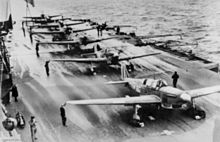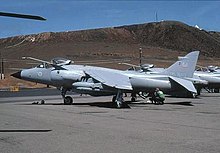809 Naval Air Squadron
| 809 Naval Air Squadron | |
|---|---|
 Squadron badge | |
| Active | 1941–1946 1949–1959 1963–1965 1966–1978 1982 2023–present |
| Country | |
| Branch | |
| Part of | Fleet Air Arm |
| Home station | RAF Marham |
| Motto(s) | "Immortal" |
| Aircraft | Lockheed Martin F-35B Lightning |
| Battle honours | Arctic 1941 Malta Convoys 1942 North Africa 1942 Salerno 1943 South France 1944 Aegean 1944 Burma 1945 Falklands 1982 |
| Commanders | |
| Current commander | Commander Nick Smith[1] |
809 Naval Air Squadron (809 NAS), nicknamed the Immortals, is a squadron of the
In December 2023, 809 NAS was recommissioned at RAF Marham, Norfolk, to operate the Lockheed Martin F-35B Lightning.[2][3] The unit is jointly manned by both Royal Navy and Royal Air Force personnel and operates from Queen Elizabeth-class aircraft carriers.[4]
History
Second World War

Formed on 15 January 1941 at RNAS St Merryn with 12 Fairey Fulmars,[5] the squadron embarked in HMS Victorious in July 1941.[6] At first involved in operations against Petsamo and Bodø, and then the convoys to North Russia, Victorious and her air group fought in the Mediterranean from July 1942, including participating in Operation Pedestal.[5]
After being trained in army co-operation duties at Sawbridge, 809 re-embarked in Victorious in October 1942 and conducted tactical reconnaissance for the North African landings of Operation Torch. After being re-equipped with the Supermarine Seafire IIc, the squadron provided cover for Operation Avalanche, the allied landings at Salerno.[5]
The squadron flew Seafires off

The final days of World War II saw 809 providing fighter cover for
Post-War
In January 1949, the
Cold War

809 NAS re-formed on 15 January 1963 as the second frontline
809 re-formed in 1966 under the command of Lt Cdr Lyn Middleton and was now equipped with the Rolls-Royce Spey-powered Buccaneer S.2. Royal Navy Buccaneers were now being painted dark sea grey overall with all markings other than roundels in either light grey or light blue to reduce visibility. 809 embarked in HMS Hermes with six aircraft for the next two years, then from 1968 were shore-based again at Lossiemouth, during which time they formed a display team and attended many air shows.
In 1970, having increased its complement to 14 Buccaneer S.2s, 809 embarked in
Falklands War

During the
It was planned to form a third front line squadron with ten Sea Harriers, but only eight could be brought together initially. These aircraft were painted a lighter low visibility grey than the rest of the Sea Harrier fleet, and were then issued to the reformed 809 NAS, under Lieutenant Commander Tim Gedge, which were transported south on the ill-fated
F-35B Lightning (2023–present)

In September 2013, it was announced that 809 NAS was to be reformed to become the first Fleet Air Arm squadron to be equipped with the Lockheed Martin F-35B Lightning.[10][11] In 2016, it had been planned that the squadron would be recommissioned in April 2023 as the UK's second frontline F-35B squadron after No. 617 Squadron RAF, however this was delayed until later in 2023.[12][13]
In September 2022, James Heappey, the Minister of State for the Armed Forces, stated that 809 NAS was "due to stand up in quarter two of 2023", with full operating capability expected in 2025.[14] 809 NAS formally stood-up at RAF Marham, Norfolk, on 8 December 2023 and is expected to be "deployable" in 2025.[15]
Aircraft flown
List of aircraft operated by 809 NAS:[7]
- Fairey Fulmar Mk.II (Jan 1941–Mar 1943)
- Supermarine Spitfire Mk.Va (Mar 1943–June 1943)
- Supermarine Seafire Mk.Ib (Apr 1943–Aug 1943)
- Supermarine Seafire L.IIc (Mar 1943–Oct 1944)
- Supermarine Seafire L.III (July 1944–Dec 1945)
- Supermarine Seafire F.XV (Nov 1945–Dec 1945)
- Supermarine Seafire F.XVII (Nov 1945–Jan 1946)
- De Havilland Sea Hornet NF.21(Jan 1949–May 1954)
- De Havilland Sea Venom FAW.21 (May 1954–Aug 1959)
- Blackburn Buccaneer S.1 (Jan 1963–Mar 1965)
- Blackburn Buccaneer S.2 (Jan 1966–Dec 1978)
- Hawker Siddeley Sea Harrier FRS.1 (Apr 1982–Dec 1982)
- Lockheed Martin F-35B Lightning (Dec 2023–present)
Notes
- ^ "Leader of reborn Immortals living his dream with 809 Squadron flying the F-35". forces.net. 11 December 2023. Retrieved 20 December 2023.
- ^ "Building up the Lightning Force – when will the UK get its F-35 jets? | Navy Lookout". 14 September 2022.
- ^ @NavyLookout (8 December 2023). "@NavyLookout F-35 with @809NAS 'phoenix from the flames' tail art on display at @RAF_Marham as the squadron recommissions today" (Tweet). Retrieved 8 December 2023 – via Twitter.
- ^ "'Immortal' Naval Air Squadron 809 NAS to fly Navy's newest jets". Royal Navy. 9 September 2013. Archived from the original on 19 January 2014. Retrieved 10 September 2013.
- ^ a b c d e f g "809 NAS at the Fleet Air Arm Archive website". Archived from the original on 22 January 2010. Retrieved 31 January 2010.
{{cite web}}: CS1 maint: unfit URL (link) - ^ "No. 809 Naval Air Squadron (FAA): Second World War". History of War. Retrieved 13 May 2021.
- ^ a b "809 Naval Air Squadron". www.wings-aviation.ch. Retrieved 13 May 2021.
- ^ "The Suez Crisis (Operation Musketeer) 1956". Imperial War Museum. Retrieved 13 May 2021.
- ^ Rowland White, Phoenix Squadron: HMS Ark Royal, Britain’s Last Top Guns and the Untold Story of Their Most Dramatic Mission, BANTAM PRESS.
- ^ "The jump jet of tomorrow". royalnavy.mod.uk. Royal Navy. 23 September 2013. Archived from the original on 2 February 2014. Retrieved 24 September 2013.
- ^ "809 Naval Air Squadron". royalnavy.mod.uk. Royal Navy. Retrieved 9 September 2013.
- ^ Stevenson, Beth (20 May 2016). "UK F-35 commander highlights training challenge". Flight Global.
- ^ "Top British F-35 Pilot on How His Fledgling Team is Forging Its Own Path Forward". 15 March 2021.
- ^ "F-35 Aircraft: Procurement - Question for Ministry of Defence". www.parliament.uk. UK Parliament. 6 September 2022. Retrieved 18 February 2023.
- ^ "Immortals return: 809 Squadron rises from the ashes to operate the F-35B". forces.net. 8 December 2023. Retrieved 20 December 2023.
References
- Pitchfork, Air Commodore Graham (2002). The Buccaneers: Operational Service with the Royal Navy and Air Force. Sparkford: Patrick Stephens. ISBN 1-85260-611-8.
